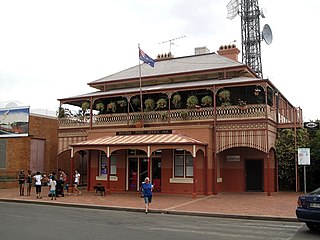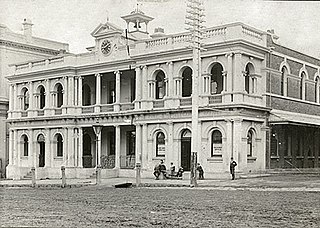Related Research Articles
A Postmaster General, in Anglosphere countries, is the chief executive officer of the postal service of that country, a ministerial office responsible for overseeing all other postmasters.

Telecommunications in Australia refers to communication in Australia through electronic means, using devices such as telephone, television, radio or computer, and services such as the telephony and broadband networks. Telecommunications have always been important in Australia given the "tyranny of distance" with a dispersed population. Governments have driven telecommunication development and have a key role in its regulation.

Postmaster General of the United Kingdom was a Cabinet ministerial position in HM Government. Aside from maintaining the postal system, the Telegraph Act 1868 established the Postmaster General's right to exclusively maintain electric telegraphs. This would subsequently extend to telecommunications and broadcasting.

The Minister for Posts and Telegraphs was the holder of a position in the Government of Ireland. From 1924 until 1984 – when it was abolished – the minister headed the Department of Posts and Telegraphs, the government-run postal, telegraph and telephone service covering the Republic of Ireland.

Telstra Tower is a telecommunications tower and lookout that is situated above the summit of Black Mountain in Australia's capital city of Canberra. It is named after Australia's largest telecommunications company, Telstra Corporation. The Tower sits within the InfraCo division, which is responsible for its operations and maintenance. Rising 195.2 metres (640 ft) above the mountain summit, it is a landmark in Canberra and offers panoramic views of the city and its surrounding countryside from an indoor observation deck and two outdoor viewing platforms.

Australia Post, formally known as the Australian Postal Corporation, is a Commonwealth government-owned corporation that provides postal services throughout Australia. Australia Post's head office is located on Bourke Street, Melbourne, above the Bourke Street Post Office.

The Postmaster-General's Department (PMG) was a department of the Australian federal government, established at Federation in 1901, whose responsibilities included the provision of postal and telegraphic services throughout Australia. It was abolished in December 1975 and replaced by the Postal and Telecommunications Department. Two separate legal entities had been established in July 1975 to take over the department's operations: Telecom Australia and Australia Post.
Section 51(v) of the Constitution of Australia is a subsection of Section 51 of the Constitution of Australia that gives the Australian Parliament power to legislate on "postal, telegraphic, telephonic, and other like services".

The Australian Minister for Communications has the overall responsibility for broadcasting, the information and communications technology industry, the information economy, and telecommunications within Australia. The portfolio is currently held by Michelle Rowland in the Albanese ministry since 1 June 2022, following the Australian federal election in 2022.

The General Post Office (GPO) was the state postal system and telecommunications carrier of the United Kingdom until 1969. Established in England in the 17th century, the GPO was a state monopoly covering the dispatch of items from a specific sender to a specific receiver ; it was overseen by a Government minister, the Postmaster General. Over time its remit was extended to Scotland and Ireland, and across parts of the British Empire.
The Telecommunication Society of Australia (TSA) has served the Australian telecommunications industry as its learned society since its initial formation as the Telegraph Electrical Society in 1874, in response to enthusiasm for the then new engineering science of electrical telegraphy. Since then the Society has evolved in response to the industry’s growth through successive phases of industry restructuring: the introduction of telephony by the private sector (1880); nationalization following Federation of Australia (1901); the passing of the Postmaster-General's Department's monopoly role (1902–1975) to the arms-length government business Telecom Australia (1975–92); and the introduction of competition with the staged privatisation of Telecom Australia’s successor, Telstra, in 1991, 1997 and 2005.
The Australian Department of Communications and the Arts was a department of the Government of Australia charged with responsibility for communications policy and programs and cultural affairs.
The Department of the Media was an Australian government department that existed between December 1972 and December 1975.

The Department for Business, Energy, and Industrial Strategy (BEIS) was a department of His Majesty's Government.

Ministry of Communications is a Central ministry under the Government of India responsible for telecommunications and postal service. It was carved out of Ministry of Communications and Information Technology on 19 July 2016.

Bourke Post Office is a heritage-listed post office at 47 Oxley Street, Bourke, Bourke Shire, New South Wales, Australia. It was designed by the Colonial Architect's Office under James Barnet and built in 1880 by E. Heseler. It is also known as Bourke Post and Telegraph Office. The property is owned by the Keane Family Trust. It was added to the New South Wales State Heritage Register on 23 June 2000.

Junee Post Office is a heritage-listed post office at 119 Lorne Street, Junee, Junee Shire, New South Wales, Australia. It was designed by Designed by the Colonial Architect's Office under James Barnet and built by Gatby and Flock. The property is owned by Australia Post. It was added to the New South Wales State Heritage Register on 22 December 2000.

The Orange Post Office is a heritage-listed post office located at 221 Summer Street, Orange, City of Orange, New South Wales, Australia. It was designed by Designed by the Colonial Architect’s Office under James Barnet and built by J. Douglas. The property is owned by Australia Post. It was added to the New South Wales State Heritage Register on 22 December 2000.
The Australian Telecommunications Employees' Association (ATEA) was an Australian trade union representing technical and trades employees in the telecommunications industry from 1912 to 1992. Its members were primarily employed by the Postmaster-General's Department, the Australian Broadcasting Control Board and the Department of Posts and Telecommunications.
References
- 1 2 3 4 CA 1959:Postal and Telecommunications Department, Policy Secretariat, [Canberra], National Archives of Australia, retrieved 5 December 2013
- 1 2 Fraser, Malcolm (18 December 1975). "MAJOR CHANGES IN MINISTERIAL AND DEPARTMENTAL RESPONSIBILITIES AND FUNCTIONS" (Press release). Archived from the original on 11 January 2014.